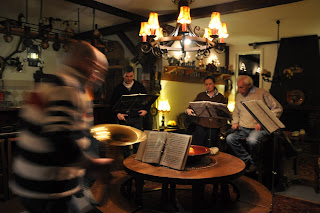
These last few days, we were in Naarden/Bussum, visiting Karel's dad. The reason for the slash in the name is that Bussum has grown over the last few-hundred years, incorporating Naarden into it. Naarden, on the other hand, has not grown at all--not for a lack of trying, but because it's an island ringed by a fortress, a moat, and an extra wall. The locals take an inordinate amount of glee pointing out the old church, which still has cannonballs from some battle back-in-the-day stuck in its walls.
The purpose for the visit, as Karel explained it, was to help his dad make a venison paté, and to attend a bugling practice session in the hopes of placing better than dead last in the Dutch-German bugling contest to be held later this year. Yes, he said that with a straight face. And I have the photographic evidence that such things are anticipated by people other than Karel, as well.
It always seems to surprise people to know that there are hunters in the Netherlands, given the "eco-green" ethos that pervades the country--I mean, the recycling stations in Maastricht have spots for paper, plastic, glass, and cans, while in Nijmegen one must learn the art of parsing trash. In addition, the paperwork required to own a gun is famously tedious, and serves as a deterrent for all but the most dedicated gun buffs.
But the fact is, hunters are an essential part of wildlife management. If you divide the parts of the Netherlands that are not farmed into developed versus wildlife preserves, then it's about a 50:50 (at most 60:40) split. These little islands of wildlife are home to an astonishing array of edible animals, including deer (seen), pheasant (seen), hare (seen), and wild boar (not-seen, and thank God, because I'm not sure I'd be alive to tell the tale if I had seen one). What this means is that, in order to maintain a healthy balance of animals-versus-plants, that something must regularly cull the cute-n-fuzzies. It used to be that wolves did this, but the last wolf disappeared from the Netherlands 150 years ago, so hunters had to take their place. Not that people like Karel and his father are complaining--Karel's particular area of expertise is, surprisingly (given his job), guns and how to shoot them. And perhaps more importantly, how to prepare the things that are on the wrong end of the bullet.
So the venison paté that Karel made with his dad came entirely from animals that his father had shot himself (Karel, for all that he can shoot like a sniper, long ago lost his appetite--never very strong to begin with--for hunting). It's an interesting, if stinky*, connection to one's food that most people can't appreciate.
*I'm not at all squicked out by the sight, smell, or feel of dead animals--but the scent of the cooking pate was vaguely reminscent of dog food.
No comments:
Post a Comment